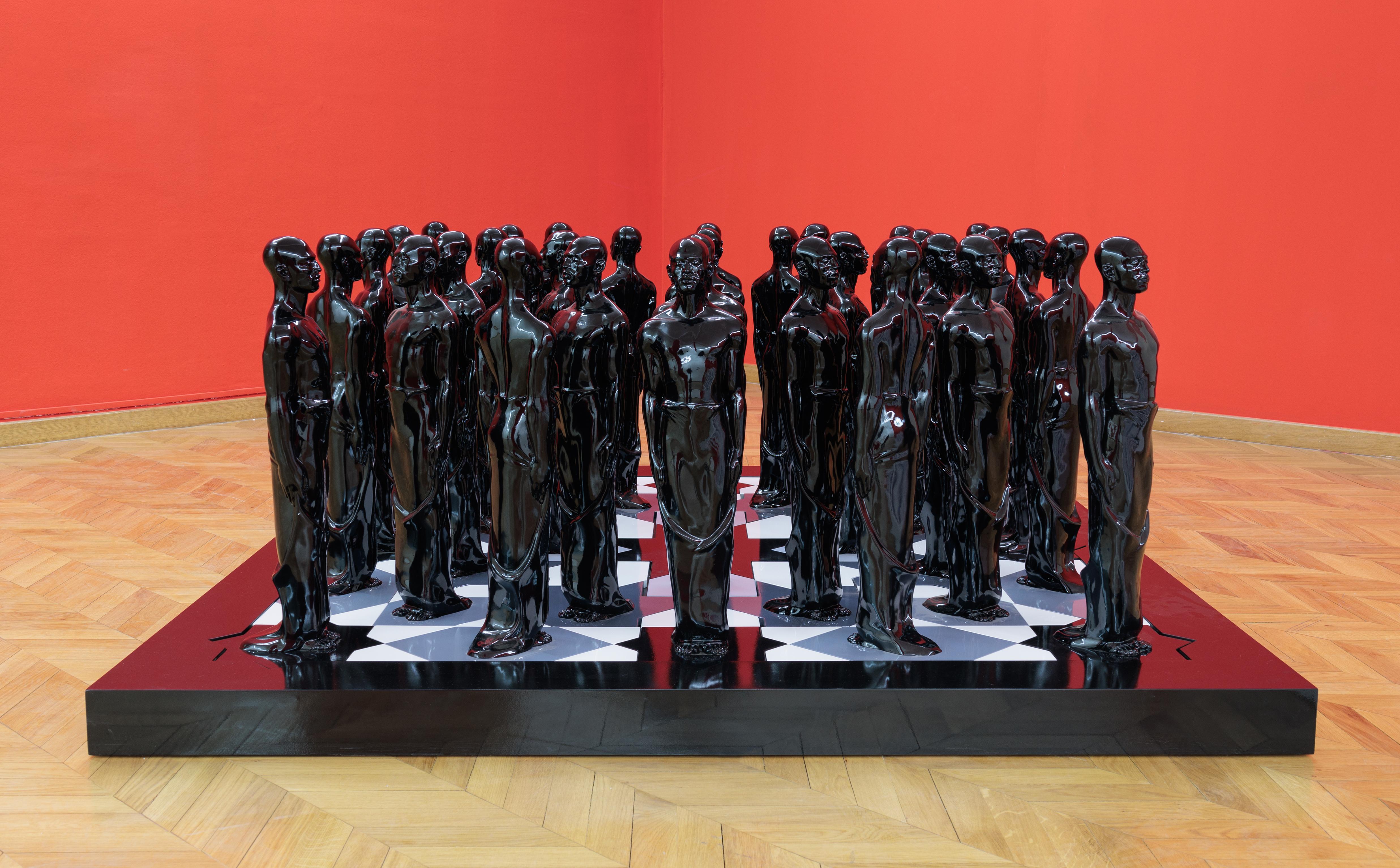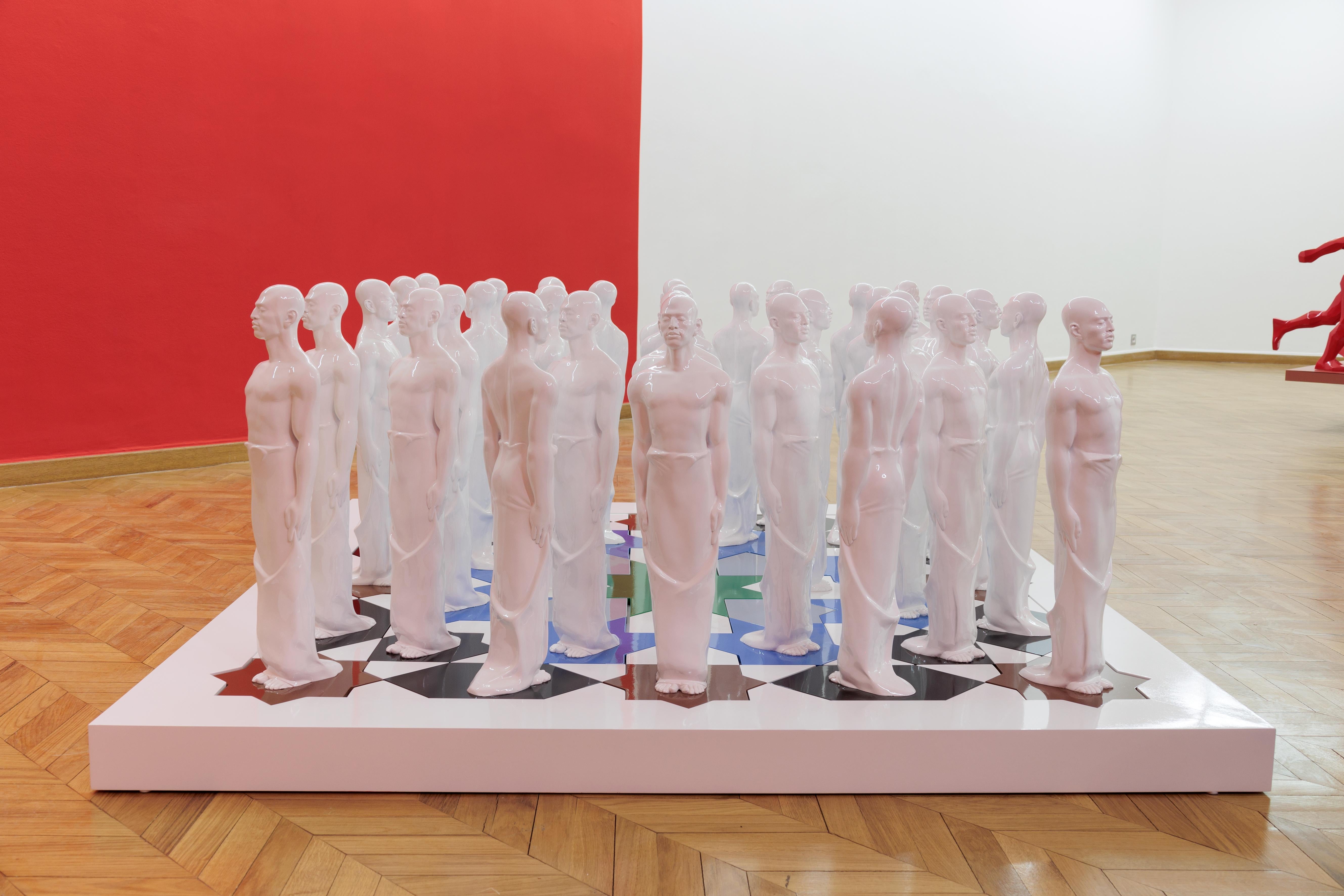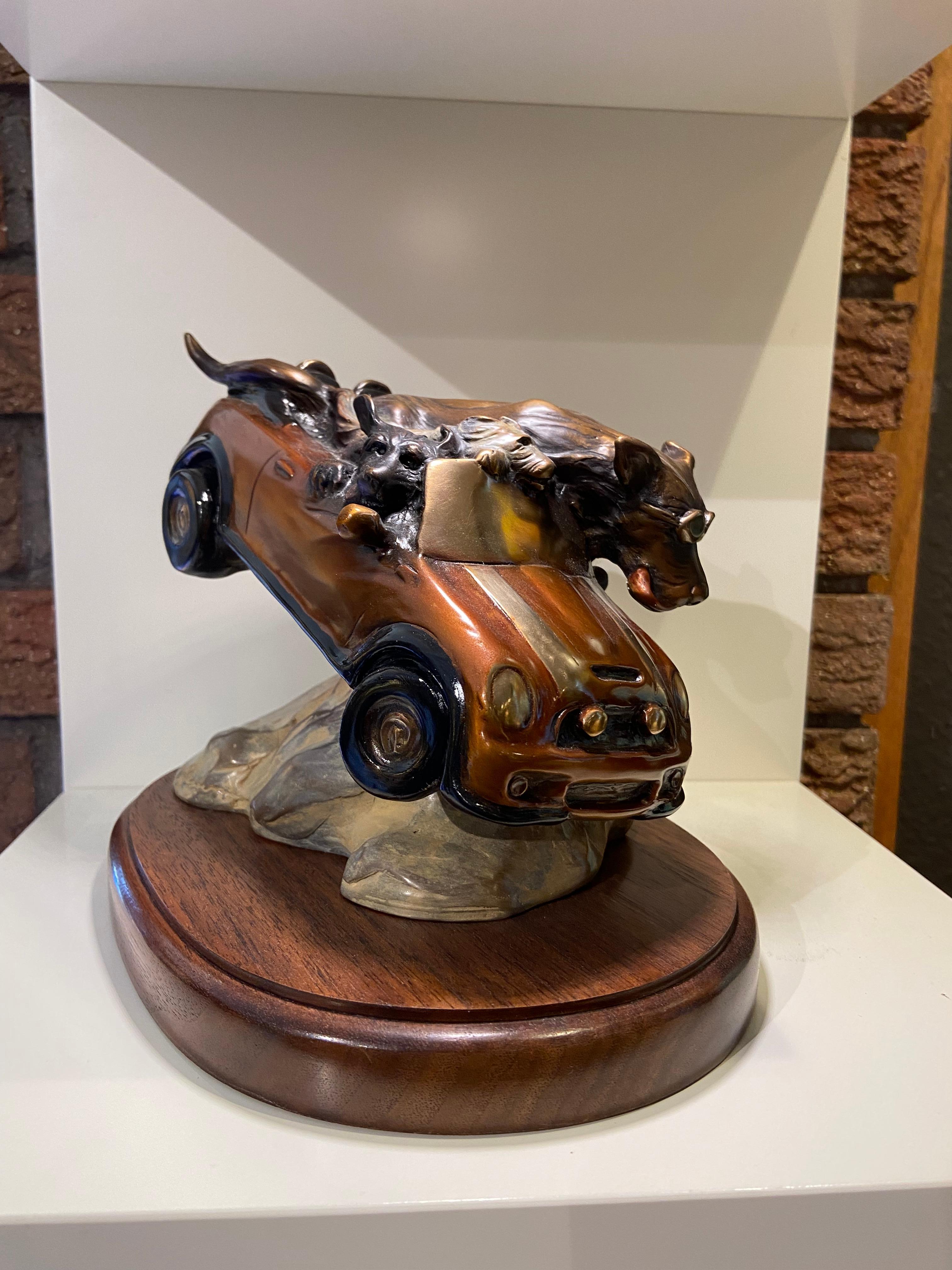Items Similar to Large Neapolitan 19th Century Hardwood Sculpture of a Crèche Camel.
Video Loading
Want more images or videos?
Request additional images or videos from the seller
1 of 22
UnknownLarge Neapolitan 19th Century Hardwood Sculpture of a Crèche Camel.1890s
1890s
About the Item
Large, Neapolitan, late 19th Century hardwood sculpture of a camel. Artist unknown.
A beautifully patinated hardwood sculpture. The sculpture is extremely charming and having been handled for over a century has a lovely warm and tactile patina. It is particularly nice too see the work of the craftsperson in the adze and chisel marks along the body of the sculpture. The Italians and most notably the area around Naples has a long and storied tradition in the creation of sculptures for Nativity Scenes. This camel is both an endearing item and a piece of social history.
A wonderful addition in its own right to the traditional Christmas scene, by tradition this sculpture was used as a maquette for the production of papier-maché models used in Christmas Creches which have such a long tradition in Italy and throughout the world. Wonderfully carved this piece was used to create hollow models out of papier-maché which were more affordable for this Christmas tradition. Hundreds of strips of papier-maché would be layered onto the figure in all directions. Then using a sharp tool the papier-maché was pushed into all the crevices of the sculpture to give it crisp detail. Once the layers of paper were dry the papier-maché was cut at certain points and lifted off the sculpture. Then finally the resulting body parts were glued back together, painted and patinated ready to be placed in the crèche scene.
In the Christian tradition, a nativity scene (also known as a manger scene, cribor, crèche, or in Italian presepio or presepe, or Bethlehem) is the special exhibition, particularly during the Christmas season, of art objects representing the birth of Jesus.
Other characters from the nativity story, such as shepherds, sheep, and angels may be displayed near the manger, as described in the Gospel of Luke. A donkey and an ox are typically depicted in the scene, and the Magi and their camels, described in the Gospel of Matthew, are also included. Many also include a representation of the Star of Bethlehem. Several cultures add other characters and objects that may or may not be Biblical.
Saint Francis of Assisi is credited with creating the first live nativity scene in 1223 in order to cultivate the worship of Christ. He himself had recently been inspired by his visit to the Holy Land, where he'd been shown Jesus' traditional birthplace. The scene's popularity inspired communities throughout Christian countries to stage similar exhibitions.
- Creation Year:1890s
- Dimensions:Height: 20.08 in (51 cm)Width: 19.3 in (49 cm)Depth: 5.52 in (14 cm)
- Medium:
- Movement & Style:
- Period:
- Condition:Areas of old glue on the saddle. Some cracking commensurate with age.
- Gallery Location:Cotignac, FR
- Reference Number:
About the Seller
5.0
Platinum Seller
These expertly vetted sellers are 1stDibs' most experienced sellers and are rated highest by our customers.
Established in 2000
1stDibs seller since 2020
165 sales on 1stDibs
Typical response time: 1 hour
- ShippingRetrieving quote...Ships From: Cotignac, France
- Return PolicyA return for this item may be initiated within 3 days of delivery.
More From This SellerView All
- African zoomorphic puppet head sculpture from the Bozo Tribe in Mali.Located in Cotignac, FREarly 20th century zoomorphic African puppet head sculpture from the Bozo tribe in Mali. This puppet head would have been used by the Bozo ethnic group during the Sogobo ceremony. This ancestral tradition continues in the region of Segou in Mali along the Niger river. It is an opportunity to regroup the different villages and give rise to musical and theatrical performances whose highlight is the puppet show...Category
Mid-20th Century Tribal Figurative Sculptures
MaterialsMetal
- Colourful Mixed Media Sculptural 'Montage' , Manau Tupapau. Hommage to Gaugin.By Armand AvrilLocated in Cotignac, FRGaugin inspired 21st Century montage titled 'Manau Tupapau' (spirit of the dead watching) by French artist, Armand Avril. Mounted and presented in a custom built painted tray frame and signed and dated 2004 both front and back with a later sketch of his favourite dog Dimar in repose to the reverse. This montage fully demonstrates Avril's inspiration drawn from tribal art and Gaugin's famous painting of a Tahitian nude whilst also expressing the humour and joy that he puts into all his work. A very strong sculptural image and a feast for the eyes in searching for and recognising the materials used in making this piece come alive. This montage is made from carved wood pieces, paint, clothespegs and cardboard . Armand Avril was born in 1926 in Lyon. His father, Marcel Avril was a painter and collector of African art. At 16 Armand became an apprentice shepherd in Provence. Avril could always be seen equipped with a sketchbook and a book on the history of art whilst tending his flock. It was not until the age of 30, in 1956, that Armand embarked on painting as an autodidact, influenced by Raoul Dufy, Pierre Bonnard, Henri Matisse and the Lyonnaise School of Painting. He exhibited for the first time in 1957. In 1960, he left for a one-year trip to Africa. There he met the painter Jean Arène who introduced him to the village of Cotignac in the Var and to Louis Pons...Category
21st Century and Contemporary Expressionist Mixed Media
MaterialsWood, Acrylic, Cardboard
- Native North American Hopi Katsina (Kachina) Doll.Located in Cotignac, FRNative North American carved wood and painted effigy figure, Hopi Katsina or Kachina doll. This is one of a group of eight dolls all individually priced, or available as a set, and ...Category
Mid-20th Century American Impressionist Figurative Sculptures
MaterialsWood, Paint
- A Large Scale, Beautifully Sculpted and Patinated Batcham Cameroon Mask.Located in Cotignac, FRA large scale and beautifully carved wooden ceremonial mask from Cameroon. There are traces of colour and decoration to the surface and the mask has a magnificent patina giving it a wonderful presence as a sculptural object. The Batcham Mask or simply the Batcham originated in western Cameroon although its name refers to the place where it was first found: Batcham. This is a ceremonial mask from the Bamileke culture in the western Grasslands of Cameroon. This tall crest (76 cm in height) has clearly defined features, a powerful yet calm visage, sharply chiselled diamond and triangular furrows, and nearly perfect symmetry. Such painstaking craftsmanship underscores the sophistication and control of the sculptor in preparing this ceremonial piece. It shares the elements of Batcham masks including: The general morphology is built on two axes: a symmetrical vertical axis with chiseled furrows, stylized eyes, lips, nostrils, mouth and teeth; a horizontal axis presenting swollen cheeks, an ovular mouth showing multiple teeth, and triangular ears supported on a hollow cylindrical base. One interpretation is that the masks depict a hippopotamus emerging from watery depths, conveying nature’s power conferred to enthroned royalty. The Batcham mask represents the pi, or double animal of a great dignitary of the kingdom. It was used by a great dignitary of the Msop society who intervened only on rare occasions: during the funeral and enthronement of the king and the nine notables, and to perform the Royal Tso dance, elephant dance...Category
20th Century Tribal Sculptures
MaterialsPaint, Plaster, Wood
- Native North American Hopi Katsina (Kachina) Doll.Located in Cotignac, FRNative North American carved wood and painted and articulated effigy figure, Hopi Katsina or Kachina doll. This is one of a group of eight dolls all individually priced, or availabl...Category
Mid-20th Century American Impressionist Figurative Sculptures
MaterialsWood, Paint
- An Early 20th Century Cigar Store Indian, Carved Wood With Polychrome DecorationLocated in Cotignac, FRA 20th Century wood carved male figure, a 'Cigar Store Indian' with original polychrome decoration. A now controversial subject, but none the less charming rendition, of a native North American man originally probably used as an advertising figure. Wonderful quality of carving capturing the stance of the man looking out to the distance, hair flowing to his back and plait to the side, all the details of his costume, his native dress and hairpipe breastplate (suggesting he is possibly a Comanche) and chest ornament, apron, trousers, mocassins, shield and arrows. The original Polychrome decoration has weathered beautifully as has the wood itself to present a sculpture that would adorn any collection or interior. Because of the general illiteracy of the populace, early store owners used descriptive emblems or figures to advertise their shops' wares. American Indians and tobacco had always been associated because American Indians introduced tobacco to Europeans. As early as the 17th century, European tobacconists used figures of American Indians to advertise their shops. Because European carvers had never seen a Native American, these early cigar-store "Indians" looked more like Africans with feathered headdresses and other fanciful, exotic features. These carvings were called "Black Boys" or "Virginians" in the trade. Eventually, the European cigar-store figure...Category
Mid-20th Century American Realist Figurative Sculptures
MaterialsWood, Paint
You May Also Like
- Spiritualité IIILocated in Marrakech, MA| About the work A child of another South, Diadji "gives body" to this word , Fraternity and enriches the lexicon of plastic expressions known in Morocco with characters, inhabited b...Category
2010s Realist Figurative Sculptures
MaterialsEpoxy Resin, Wood
- Spiritualité IILocated in Marrakech, MA| About the work A child of another South, Diadji "gives body" to this word , Fraternity and enriches the lexicon of plastic expressions known in Morocco with characters, inhabited b...Category
2010s Realist Figurative Sculptures
MaterialsEpoxy Resin, Wood
- Max n' MiniBy Gary AlsumLocated in Loveland, COMax 'n Mini by Gary Alsum Bronze mini-coop driven by dogs 6.5x8x6.5 ed/75 #1 available some additional views are shown in clay. The finished piece is the red patina. Shipping price ...Category
2010s Realist Figurative Sculptures
MaterialsBronze
- Bustin' OutBy Gary AlsumLocated in Loveland, CO"Bustin' Out" by Gary Alsum Colorful Bronze Fish Sculpture 6x6.5x5" ed/50 Great for any outdoor enthusiast's desk to remind them they'd rather be fishing. ABOUT THE ARTIST: Taking the knowledge passed on from artists such as Fritz White, Glenna Goodacre...Category
2010s Realist Figurative Sculptures
MaterialsBronze
- Wooden Maquette of a Leg, Hand Carved British SculptureLocated in London, GBHand-carved wooden trunk and plinth Height: 38 1/2 inches (98 cm) Width: 10 1/2 inches (27 cm) Lawson Rudge Lawson Rudge was born in 1936. He is...Category
20th Century Realist Figurative Sculptures
MaterialsWood
- Medieval Style Carved Statue of 3 Religious FiguresLocated in San Antonio, TXMedieval style carved sculpture of three religious figures, possibly saints. The sculpture is in the style of Gothic religious art from continental Europe, particularly Germany and F...Category
16th Century Realist Figurative Sculptures
MaterialsWood





